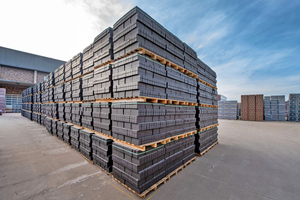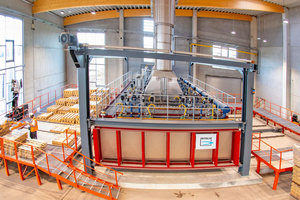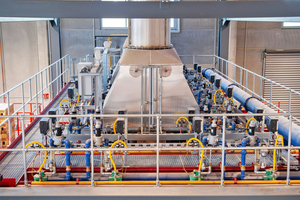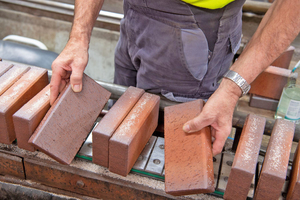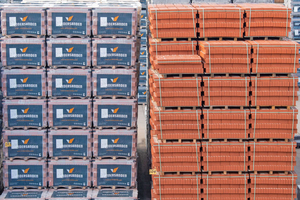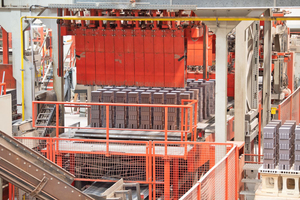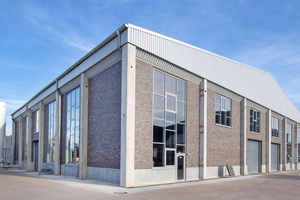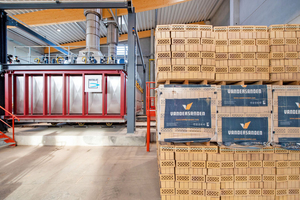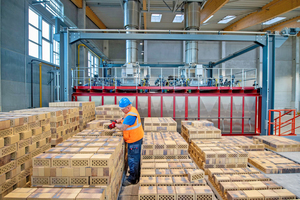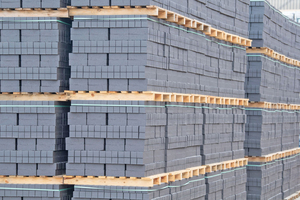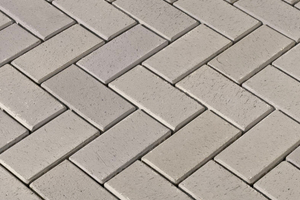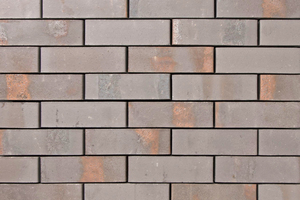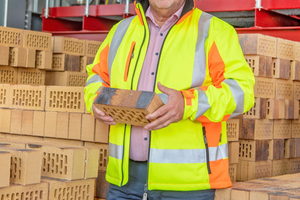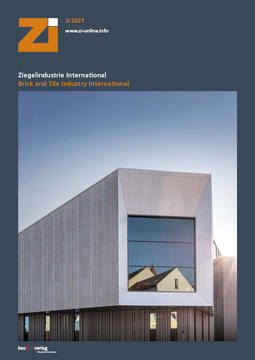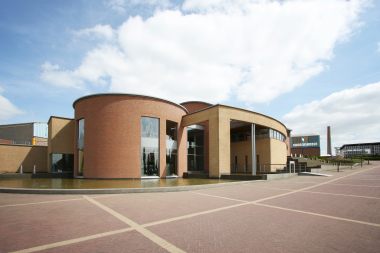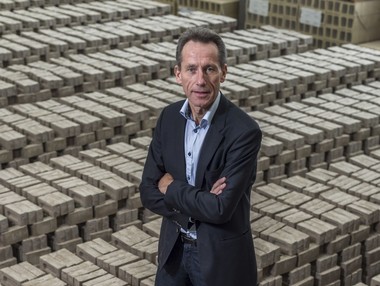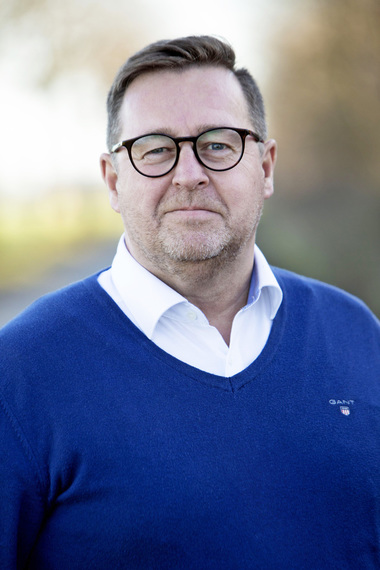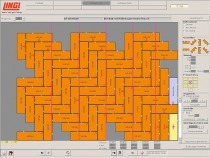“The warm grey trend colour of bricks is only achieved
by Vandersanden”
A new fashion wave is reflected in the design of garage driveways, gardens, public squares and façades: A warm grey is the trend colour for modern clay pavers and façade bricks. According to the company’s own statement, this warm grey is only achieved by the Vandersanden brick specialist and is conjured by the brick experts from domestic raw materials and by means of a special steaming process.
Thanks to the new steaming kiln, commissioned in the Upper Lusatia region of Germany in 2020 to produce Vandersanden bricks, above all everything runs environmentally friendly. Helge Behrens, CEO of Vandersanden Deutschland GmbH, talks about facts & figures, current brick fashions and his more than fifty reliable and satisfied employees working at the Upper Lusatia facility. Moreover, the responsible head of the Vandersanden company in Germany advocates a sustainable use of resources and gives an outlook on other design trends.
The recipe for steam-treated clay pavers and facing bricks
The steaming of clinker bricks is an art of its own. It does not only require special equipment, such as the new, very energy-efficient kiln, which Vandersanden had installed in its Upper Lusatia factory now. The recipe plays a decisive role too if you want to bake bricks in a warm grey shade. The ingredients: a very special raw material. Luckily, this is available in the clay pits in the immediate vicinity of the Upper Lusatia factory. The first, a very rich pit is no more than one kilometre away, the second pit, from which Vandersanden extracts very special and valuable clays, is less than eight kilometres away.
The method: Take a huge hood-type kiln which looks like an over-sized cake cloche. Extrude and fire clay pavers or facing bricks in the usual manner. Afterwards, the bricks are placed onto the steaming kiln car specifically developed for this purpose. As soon as the kiln car has been loaded completely, Vandersanden steams the bricks in the new kiln according to an in-house recipe using a special procedure: for five to six days in an extremely oxygen-deficient atmosphere at above 70 degrees. About one week later the clay pavers and façade bricks are cooked thoroughly. This results in the finished, warm grey bricks which many customers virtually snatch away from the Vandersanden brick experts.
CEO Helge Behrens about the new trend colour for clay pavers
“We have a very particular specialty quite close to our factory in Upper Lusatia,” says Helge Behrens, CEO Vandersanden Deutschland GmbH. “Namely an excellent clay for the steaming of bricks.” And that’s exactly what Vandersanden is doing with its new steaming kiln in Upper Lusatia. Because the popular pavers in the stylish, pleasant grey are produced in a firing and cooling process according to the secret recipe. And grey is the absolute trend colour, specifically for clay pavers.
“I am not surprised by the hype about the grey clay pavers,” states Vandersanden CEO Helge Behrens. “As far as pavers are concerned, grey is an extremely difficult colour shade. At the moment, I can only think of pavers made of white-firing clay. To blend this into the grey shade, aggregates must be added. However, the resulting grey appears quite cold. Our clay pavers in contrast have a cordial, warm character. As far as I know, only Vandersanden is able to create this pleasant colour shade.”
New energy-efficient hood-type kiln for steaming of bricks
In order to respond to the enormous demand, Vandersanden had a new hood-type kiln built at the Upper Lusatia facility, which is now steaming the popular grey pavers around the clock. “With the new kiln, we are producing about 65 tons of new bricks per kiln charge,” the Vandersanden head Behrens is pleased to note proudly. “Our new brick kiln is one of the most modern kilns throughout Europe, and therefore we are also at the very forefront in terms of resource efficiency,” Behrens continues. “Steaming of bricks is very popular in other European countries. In this regard, I think of Denmark, for instance. And the market in the Netherlands is so vast that there are contract manufacturers for steaming. That is to say, companies which do nothing but finish clinker bricks, without making them themselves. Of course, I am very pleased that steam-treated bricks are now attracting so much interest in Germany too. And with our brand-new kiln we are geared up!”
The Vandersanden objective of sustainability: bricks for perpetuity
“We are currently experiencing a renaissance of clay pavers in Germany”, Behrens continues. “We are indeed very pleased about this. And we attribute this to two fundamental effects. On the one hand, when looking at this year, you cannot get around a coronavirus effect. A lot of final customers and private clients have set up their homes more attractively instead of having a holiday. We notice this quite obviously.
The other effect is the concept of sustainability. We clearly notice a rethinking among the consumers.” In this regard, Behrens does not only refer to the advantageous amortisation costs in particular of façade bricks and brick slips, but rather the durability and the associated sustainability of the bricks. “Especially with respect to sustainability, our façade bricks and clay pavers are second to none. Any other conceivable building envelop, for example, requires renovation after ten years at the latest. This applies to concrete as well as plaster. And consequently, the brick façade has already paid itself off. Because our façade bricks are evidently maintenance-free and have the longest life cycle of all façade technologies until now. This is beneficial for the environment, since our customers do not have to deal with toxic paints and the waste materials relating to such a façade renovation.”
The CEO of Vandersanden Deutschland Behrens adds: “But also in contract business, above all architects completely opt for bricks once again. Besides the aspect of environmental protection and sustainability, the authentic style of brick-built façades plays an important role here. Just a glance to Hamburg is enough to realise a certain trend towards brick-built façades.”
Planned sustainably and in the long term: space for kiln two already taken into account
“The current demand especially for our warm grey clay pavers is so strong that we have taken the space required for a second kiln with the same dimensions into consideration directly when planning the new kiln. The factory premises allow this in terms of area. And if sales continue to be so fantastic, we will not refrain from kiln number two in the medium term.”
The foresighted planning once again underlines Vandersanden’s long-term view of brick production. The brick experts not only bear sustainability, well-being of the employees and the sales figures in mind; but the team around CEO Behrens also responds to all possible customer requests even before the customers know what they really want. “You know, we do not have a crystal ball allowing us to look into the future. But a large part of our strategic work consists of evaluating different scenarios of what the next three, five, ten or even thirty years will bring. In this regard, Vandersanden acts true to its self-imposed motto. We do not think in years or decades, but in generations.”
New: Steam-treated and tumbled bricks for a rustic look
In order to take this strategy into account, Behrens anticipates the trend for the years to come. Now, Vandersanden approaches the next level of finishing its clay pavers. At the Upper Lusatia factory, the family-run company will also produce clay pavers in the near future that are both steam-treated and tumbled. For an even more rustic and individual look of the pavers. “In this way, we want to combine modernity with tradition,” explains Vandersanden CEO Behrens.
New jobs thanks to the new kiln
“In addition, the new kiln has created a new job,” Behrens continues. “It is good and important, in particular, in the current pandemic.” Vandersanden has a total workforce of 56 people at the Upper Lusatia location. “I am very happy with my employees. Across the board, they are all really good people – moreover very motivated and innovative. A lot of fantastic ideas for optimizing processes came from direct employee feedback. It is great and makes me proud to be allowed to work together with so many creative minds.” Vandersanden is manufacturing about 40 million bricks per year at the Upper Lusatia location. The ratio of clay pavers and façade bricks is about four to one, according to CEO Behrens.

